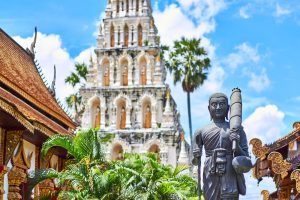Thailand is a country known for its stunning natural beauty, and one of the best ways to experience this is by visiting its national parks. These protected areas are home to some of the most unspoiled wilderness in the country, with awe-inspiring landscapes, rich biodiversity, and unique wildlife encounters. Preserving these natural treasures is of utmost importance, not only for the sake of future generations but also for the well-being of our planet.
Discovering the Unspoiled Wilderness
Thailand’s national parks offer a glimpse into unspoiled wilderness that is becoming increasingly rare in today’s world. These protected areas are carefully managed to ensure that their natural habitats remain intact and that visitors can experience the beauty of nature in its purest form. From dense jungles to pristine beaches, Thailand’s national parks are a haven for those seeking to escape the hustle and bustle of city life and immerse themselves in the tranquility of nature.
Preserving these natural habitats is crucial for several reasons. Firstly, these areas serve as important refuges for countless plant and animal species, many of which are endangered or threatened. By protecting their habitats, we are ensuring their survival and contributing to the overall health of our planet’s ecosystems. Secondly, these unspoiled wilderness areas provide essential ecosystem services such as clean air and water, carbon sequestration, and climate regulation. By preserving these habitats, we are safeguarding these vital services for future generations.
Awe-Inspiring Landscapes
Thailand’s national parks are renowned for their awe-inspiring landscapes, which encompass everything from towering mountains to cascading waterfalls and lush jungles. These natural wonders offer a feast for the senses and provide endless opportunities for exploration and adventure.
The mountains in Thailand’s national parks are a sight to behold. Whether it’s the rugged peaks of Doi Inthanon National Park or the limestone cliffs of Khao Sok National Park, these majestic mountains offer breathtaking views and a sense of awe and wonder. Hiking trails wind their way through these mountains, allowing visitors to immerse themselves in the beauty of nature and experience the thrill of conquering new heights.
Waterfalls are another highlight of Thailand’s national parks. From the iconic Erawan Falls in Erawan National Park to the secluded Namtok Phlio in Khao Chamao-Khao Wong National Park, these cascading wonders provide a refreshing respite from the heat and a chance to reconnect with the natural world. The sound of rushing water and the cool mist on your face create a sense of serenity and tranquility that is hard to find elsewhere.
Jungles are perhaps the most iconic landscapes of Thailand’s national parks. These dense forests are teeming with life, from towering trees to exotic wildlife. Exploring these jungles is like stepping into another world, where every corner holds a new discovery and every sound is a symphony of nature. The lush greenery and vibrant colors create a visual feast that is both mesmerizing and humbling.
Preserving these landscapes is essential not only for their aesthetic value but also for their ecological significance. Mountains, waterfalls, and jungles all play a crucial role in maintaining the balance of our planet’s ecosystems. They provide habitats for countless species, regulate water flow, prevent soil erosion, and contribute to climate regulation. By protecting these landscapes, we are safeguarding the health and well-being of our planet.
Biodiversity Hotspots
Thailand’s national parks are biodiversity hotspots, home to an incredible array of plant and animal species. From rare orchids to elusive tigers, these protected areas are a treasure trove of biodiversity that must be preserved for future generations.
The flora of Thailand’s national parks is incredibly diverse, with over 10,000 species of plants recorded. These include rare orchids, towering trees, and unique ferns. Many of these plant species are endemic to Thailand, meaning they are found nowhere else in the world. Preserving their habitats is crucial for their survival and for maintaining the overall biodiversity of our planet.
The fauna of Thailand’s national parks is equally impressive. From elephants and tigers to gibbons and hornbills, these protected areas are home to some of the most iconic and endangered species in the country. For wildlife enthusiasts, a visit to Thailand’s national parks offers a chance to see these animals in their natural habitats and contribute to their conservation efforts.
Preserving biodiversity is essential for several reasons. Firstly, it ensures the survival of countless plant and animal species that play important roles in our ecosystems. Each species has its own unique set of characteristics and adaptations that contribute to the overall health and functioning of our planet’s ecosystems. Secondly, biodiversity provides us with essential ecosystem services such as pollination, pest control, and nutrient cycling. By preserving biodiversity, we are safeguarding these services for future generations.
Wildlife Encounters
Thailand’s national parks offer unique opportunities for wildlife encounters that are hard to find elsewhere. From spotting rare birds to tracking elusive mammals, these protected areas provide a chance to get up close and personal with some of the most fascinating creatures on Earth.
One of the highlights of wildlife encounters in Thailand’s national parks is the chance to see rare and endangered species. From the critically endangered Indochinese tiger to the elusive clouded leopard, these protected areas provide a refuge for these animals and a chance for visitors to witness their beauty firsthand. Responsible wildlife encounters are crucial to ensure the well-being of these animals and to minimize disturbance to their natural behaviors.
Birdwatching is another popular activity in Thailand’s national parks. With over 1,000 species of birds recorded in the country, including several endemic species, birdwatchers are in for a treat. From the colorful pheasants of Doi Inthanon National Park to the majestic hornbills of Khao Yai National Park, these protected areas offer a chance to spot some of the most beautiful and rare birds in the world.
Responsible wildlife encounters are essential for several reasons. Firstly, they ensure the well-being and conservation of the animals. By following guidelines and regulations set by park authorities, visitors can minimize disturbance to the animals and contribute to their long-term survival. Secondly, responsible wildlife encounters provide an educational opportunity for visitors to learn about the importance of conservation and the need to protect these animals and their habitats.
Trekking and Hiking

Thailand’s national parks are a paradise for trekking and hiking enthusiasts. With a network of well-maintained trails that wind their way through mountains, jungles, and waterfalls, these protected areas offer endless opportunities for adventure and exploration.
Trekking and hiking in Thailand’s national parks allow visitors to immerse themselves in nature and experience the beauty of the country’s landscapes up close. Whether it’s a leisurely stroll through a jungle trail or a challenging ascent up a mountain peak, these activities provide a chance to connect with nature and challenge oneself physically and mentally.
Responsible trekking and hiking practices are crucial to ensure the well-being of both visitors and the environment. It is important to follow designated trails, respect wildlife habitats, and leave no trace behind. By practicing responsible trekking and hiking, visitors can minimize their impact on the environment and contribute to the long-term preservation of these natural areas.
Water Adventures
Thailand’s national parks are not only home to stunning landscapes but also offer a wide range of water activities for adventure seekers. From snorkeling in crystal-clear waters to kayaking through mangrove forests, these protected areas provide endless opportunities for water adventures.
Snorkeling is a popular activity in Thailand’s national parks, with vibrant coral reefs and diverse marine life waiting to be explored. Whether it’s swimming alongside colorful fish in Mu Ko Ang Thong National Park or diving into the clear waters of Similan Islands National Park, snorkeling offers a chance to witness the beauty of the underwater world and contribute to its conservation.
Kayaking is another popular water activity in Thailand’s national parks. From paddling through mangrove forests in Khao Sok National Park to exploring hidden lagoons in Phang Nga Bay, kayaking allows visitors to get up close and personal with nature and experience the tranquility of these protected areas.
Responsible water adventures are essential to ensure the well-being of marine life and the preservation of these fragile ecosystems. It is important to follow guidelines set by park authorities, avoid stepping on coral reefs, and refrain from feeding or touching marine animals. By practicing responsible water adventures, visitors can enjoy these activities while minimizing their impact on the environment.
Cultural Immersion
Thailand’s national parks are not only home to stunning natural beauty but also to vibrant indigenous communities and hill tribes. These communities have a rich cultural heritage that is deeply intertwined with the natural world, and visiting them offers a chance to learn about their traditions and way of life.
Many national parks in Thailand are home to indigenous communities and hill tribes that have lived in harmony with nature for generations. From the Karen people in Doi Inthanon National Park to the Moken sea gypsies in Mu Ko Surin National Park, these communities offer a unique insight into their traditional way of life and their deep connection with the natural world.
Preserving these cultural traditions is crucial for several reasons. Firstly, it ensures the survival of these communities and their unique way of life. By supporting sustainable tourism initiatives that benefit these communities, visitors can contribute to their economic well-being and help preserve their cultural heritage. Secondly, cultural immersion provides an educational opportunity for visitors to learn about different ways of life and foster a greater appreciation for cultural diversity.
Sustainable Tourism
Sustainable tourism is a key component of preserving Thailand’s national parks and ensuring their long-term viability. By practicing responsible travel practices, visitors can minimize their impact on the environment and contribute to the conservation efforts of these protected areas.
There are several ways to practice sustainable tourism in Thailand’s national parks. Firstly, it is important to follow guidelines and regulations set by park authorities. These may include staying on designated trails, refraining from feeding or touching wildlife, and respecting cultural traditions. By following these guidelines, visitors can minimize their impact on the environment and contribute to the well-being of the animals and communities that call these protected areas home.
Secondly, it is important to support local communities and businesses that are committed to sustainable practices. This may include staying in eco-friendly accommodations, purchasing locally made products, and supporting community-based tourism initiatives. By supporting these initiatives, visitors can contribute to the economic well-being of local communities and help preserve their cultural heritage.
Planning Your Trip
When planning a trip to Thailand’s national parks, there are several things to consider to ensure a responsible and enjoyable experience. Firstly, it is important to research the park you plan to visit and familiarize yourself with its rules and regulations. This will help you understand what is expected of visitors and how you can minimize your impact on the environment.
Secondly, it is important to pack responsibly and bring only what you need. This includes reusable water bottles, eco-friendly toiletries, and lightweight camping gear. By minimizing your waste and practicing Leave No Trace principles, you can help preserve the natural beauty of these protected areas.
Lastly, it is important to support responsible tour operators and guides who prioritize sustainability and conservation. Look for operators who have a commitment to environmental protection, support local communities, and provide educational opportunities for visitors. By choosing responsible tour operators, you can ensure that your visit to Thailand’s national parks has a positive impact on the environment and local communities.
Thailand’s national parks are a treasure trove of natural beauty and biodiversity that must be preserved for future generations. From unspoiled wilderness to awe-inspiring landscapes, these protected areas offer endless opportunities for adventure and exploration. By practicing responsible travel practices and supporting sustainable tourism initiatives, visitors can contribute to the conservation efforts of these protected areas and help ensure their long-term viability. So, pack your bags, plan your trip, and embark on a journey to discover the wonders of Thailand’s national parks.
If you’re captivated by the untamed beauty of Thailand’s national parks, you won’t want to miss out on this incredible article from Thai Tourism. They have curated a list of the most breathtaking national parks in Thailand, showcasing the country’s diverse landscapes and rich biodiversity. From the lush jungles of Khao Yai National Park to the stunning limestone cliffs of Ao Phang Nga National Park, this article will inspire you to embark on your own adventure in the wild. Check out the article here and start planning your next nature-filled getaway in Thailand.
FAQs
What are Thailand’s National Parks?
Thailand’s National Parks are protected areas of land and sea that are managed by the government to preserve the country’s natural resources and biodiversity.
How many National Parks are there in Thailand?
There are currently 127 National Parks in Thailand, covering an area of over 70,000 square kilometers.
What kind of wildlife can be found in Thailand’s National Parks?
Thailand’s National Parks are home to a diverse range of wildlife, including elephants, tigers, leopards, gibbons, macaques, deer, and many species of birds and reptiles.
What activities can visitors do in Thailand’s National Parks?
Visitors to Thailand’s National Parks can enjoy a range of activities, including hiking, camping, birdwatching, wildlife spotting, and swimming in natural pools and waterfalls.
What is the best time of year to visit Thailand’s National Parks?
The best time to visit Thailand’s National Parks depends on the specific park and the activities you plan to do. Generally, the dry season from November to February is the most popular time to visit, but some parks are best visited during the rainy season from May to October.
What are some of the most popular National Parks in Thailand?
Some of the most popular National Parks in Thailand include Khao Yai, Doi Inthanon, Erawan, and Similan Islands.




